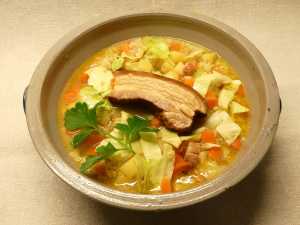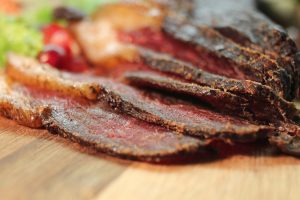Life on earth hasn’t been easy. While segregating human cultures from prehistoric times, food and subsistence have been at the center of historical analyses. In the very beginning, humans didn’t know how to make food. They were called hunter-gatherers because their daily subsistence depended on what they could hunt. After that happened the neolithic revolution, when humans understood the magic of agriculture, hence food production. Thus, if you are interested in human history, read this article to know about the oldest food in the world.
Archaeologists, paleo-botanists, and ethnographers worldwide have worked day and night to discover the gradual evolution of human history on mother earth. In the attempt of doing so, they have unearthed much evidence that points towards the oldest food in the world.
How did modern burgers and sandwiches evolve? What did our anfcestors eat? These are some of the basic questions to every human on earth, regardless of their geopolitical association.
So, the next time you munch your favorite hamburger in a restaurant around the street corner or order a salad, do compare them with the food habits of your ancestors.
Table of Contents
Oldest food in the world
There hasn’t been a break between the first food ever eaten and what we eat today. But, let’s see how far we have progressed or regressed from the first food ever made. Here is a list of the oldest food in the world:
Stew
Health-conscious people’s one-stop destination is soup and stew. But, the next time you order a bowl of soup, you will visualize the steam of a bowl of stew coming from an earthen pot and ancient humans sipping from it. Sounds fun, right? Stew is one of the oldest food in the world and dates back to 6,000 BCE.
Stew was, however, more importantly, found in colder areas of the earth. Imagine going for an animal hunt, coming back to your cave, and enjoying a bowl of hot stew in front of a bonfire. Such was the scene of leisure inside ancient cave culture.

Chapati
The scene in the Indian subcontinent was a little different. Even though the climate was much less harsh than what it is today, with the growth of agriculture, people could domesticate different plant species.
Wheat, barley, maize, and a little later paddy dominated the scene. Thus, if you go back to the Harappan civilization, you might encounter people eating chapati with a bowl of lentil soup.
Thus, bread, as is known in western cultures and chapati, in the context of the Indian subcontinent, is predominantly the first food ever made.
Proto-pita
While bread has a long history, can you imagine going back 14,000 years and discovering the oldest surviving piece of bread on earth? The ingredients were wild cereals similar to oats, einkorn, and barley. It also included tubers that provided the bread’s salty taste and gritty texture. It was discovered in the Black Desert in July 2018.
Tamales
Mesoamerican cultures like the Incas and the Aztecs made Tamales their dinner. Well, this is a kind of an old rendition of today’s rolls or wraps. Masha was a dough used as a wrapper and servings of veggies or meats or poured inside and wrapped with the Masha.
After that, it was further wrapped in a corn husk and put over steam. So, while there was no concept of frying the food back in those days, this is somewhat similar to our appetite for boiled momos.
Curry
Take up any Indian vegetable, add spice and water to it, you will serve yourself a delightful curry of that veggie. While India was always famous for spice production whole of its colonial conquest can be traced back to that, curry has predominated the food map of the world since ancient times.
As far as the Indian subcontinent is concerned, the famous spices include coriander, pepper, cumin, etc. These are all quintessential ingredients of a finger-licking curry, but curry powder was born in the 18th century.
So, how do you think ancient Indians could develop such a spicy dish? The archaeological presence of pestle and mortar in the first urban civilization of the Indian subcontinent attest to the importance of spices in Indian cuisine.
Also, like other trade items, the food spices didn’t stick to the subcontinent alone. The tablets in Sumer, much like today’s cookbook, mention the delightful presence of a recipe of meat curry as back as 1700 BCE. Whereas in India, meat is predominantly eaten with rice, in Sumer, it was served with bread.
Antarctic Fruitcake
None of our Christmas parties will sound delicious if they miss out on the famous fruitcake, the best of Santa’s fiesta. But, did you know even fruitcakes are listed among the oldest food in the world?
A very old fruitcake was found fine inside a tin can in Antarctica when Robert Falcon Scott, a British explorer, went to explore Antarctica in the 20th century. Surprisingly, the fruit cake didn’t rot. So, how many lives do you think this fruitcake has if the cat has nine lives?
Jokes apart, Scott didn’t eat that cake and unfortunately died of extreme exposure to cold and heat. However, Antarctica Heritage Trust found it in 2017 in a hut where Scott took his shelter.

Cheese
After five hours of intense office work, a nice break with a coffee and cheese sandwich is heaven for most office goers. But, can you imagine this being the same with Egyptians dating back to thousands of years ago?
A tin of ancient cheese was found in an Egyptian tomb, and a few bacteria strain in it. So, had you been a foody archaeologist and instinctively wanted to taste the cheese, you would have already fallen on the ground before your brain could receive the signal of taste. However, before you put cheese in your bread the next time, imagine the pharaohs sitting in their courtyard and enjoying cheese in their recipes.
Salad
We were talking about salad in the earlier section. What image gets conjured up in your brain when you imagine salad? A nice glass bowl with green vegetables, minced meat, or colorful fruits in case of fruit salad, mayo, cheese, etc., right? What if you teleport yourself to the past and encounter similar servings in an ancient culture?
A shipwreck from ancient times found in the Aegean Sea has revealed pieces of evidence of some salad dressing.
After rigorous analysis, the two essential ingredients of salad that the marine archaeologists spotted are oregano and olive oil. Nowadays, oregano is a must for Italian foods, and olive oil is the best substitute for oil. Thus, found from around the Greek region, these ingredients point to the presence of salad or at least salad dressing in these regions as early as 350 BCE.
Pilaf
Asian and African history was never incorporated until recently in the Eurocentric way of writing world history. Thus, while we are talking about the oldest food in the world, we cannot neglect the rich tradition that Asian food culture has passed on.
One of the most delicious foods of South and Central Asia is pilaf. Pilaf originates from the word polow, and this is a dish that has a shared history across continents and timelines. While in 383 BCE, Alexander enjoyed the delinquency of a bowl of pilaf, the recipe found its mention in a much earlier text Mahabharata and Yajnavalkya Smriti.
The steaming yellow rice served with sweeteners, and a bowl of mutton curry is heaven on earth.
Wine
We often tend to associate luxury drinks with tea. While Industrial Revolution marked the birth of tea, luxury drinks date back way further into history.
In India, the Vedas are one of the most important historical sources. So, if you take those up, you will see an entire Veda dedicated to Soma, a plant-based drink. It was one of the most important drinks in ancient India.
In colder continents, wine was prevalent. Imagine our cave ancestor sitting with pitchers in hand and gossiping the night away.

Bone Soup
Who doesn’t know the city of Xian? The famous lineup of an entire battalion of terracotta warriors was found there. But, if you think what the first food ever made was, you will have to venture a little further to unearth the dish of bone.
Construction workers and not researchers found a bowl of bone soup that dates back to 2400 years ago. The bowl still had bones, hence stepping into history as the first evidence of bone soup in the archaeological history of China.
Beef jerky
Often we tend to associate luxury with the arrival of technology, and is also seen as a marker of civilization. The argument mostly goes like this the ancient people fought so hard for their subsistence that they didn’t have time for luxury.
However, the contrary is true. Snacking is something that we associate with modern times. But, did you know a food resembling beef jerky was an important snack in ancient days?
While now we sit with our popcorn bucket, coke can to Netflix and chill, who might say ancient people had their very own bonfire and chill methods?
Ancient people ate different types of preserved and dried meat as their favorite snack. At Wanli village, a 2000-year-old pot revealed evidence of beef jerky. Thus, bone soup and beef jerky may be topped the list of favorite snacking in 2000 BCE China.

Garum
While it is more pronounced with East and Southeast Asian cultures, Garum or fish sauce can be traced back to European food history. It derived its name from garos, a type of ancient fish. Fish blood and innards were dried and fermented. After that, it was served along with other dishes.
Isicia Omentata
As we have already seen, many of the oldest food in the world include Roman foods; in fact, in the modern-day as well, we have an abundance of Italian and continental foods. While burgers originated in the West, their ancient counterpart existed in Rome.
Barbequing, a preparation of beef, coriander, nuts, and garum sauce, led to making a 1500-year-old recipe known as Isicia Omentata. It fundamentally altered the British food culture. Thus, before hitting the street for the nearest McDs, don’t forget to pay allegiance to its ancient predecessors!
Chocolate
While Charlie got to get inside the chocolate factory and befriend its owner, did our ancestors have the same fate? They excelled in it.
The list of old food even contains chocolate in it. Thus, when wondering about the oldest food in the world, who would have known, chocolate is one of them.
We all know Switzerland to be the center of the world’s best chocolate production. But, did you know King Edward VII’s coronation on June 26, 1902, led to creating a tin of chocolates recently unearthed. The girl who received the box didn’t eat it and instead made it a family tradition to pass it untouched down the generation.
Popcorn
Tada! Here’s presenting another favorite snack of our time with primitive ancestors. The discovery of corn tassels, hasks, and stalks, along with corn microfossil, led to the theory of the presence of popcorn in ancient Peru. Dating back to more than 6700 years ago, the people of Peru were enjoying their delightful pastime with a bowl of popcorn. Instead of watching an action movie on a silver screen, they were blissfully star gazing in the Peruvian night sky.

Final Thoughts
If you are a foodie with a tinge of curiosity, this article should satisfy your hunger for food and knowledge. With a list of the oldest food in the world, keep on surfing more to travel time for unraveling the histories of your favorite present-day staple or snack!


